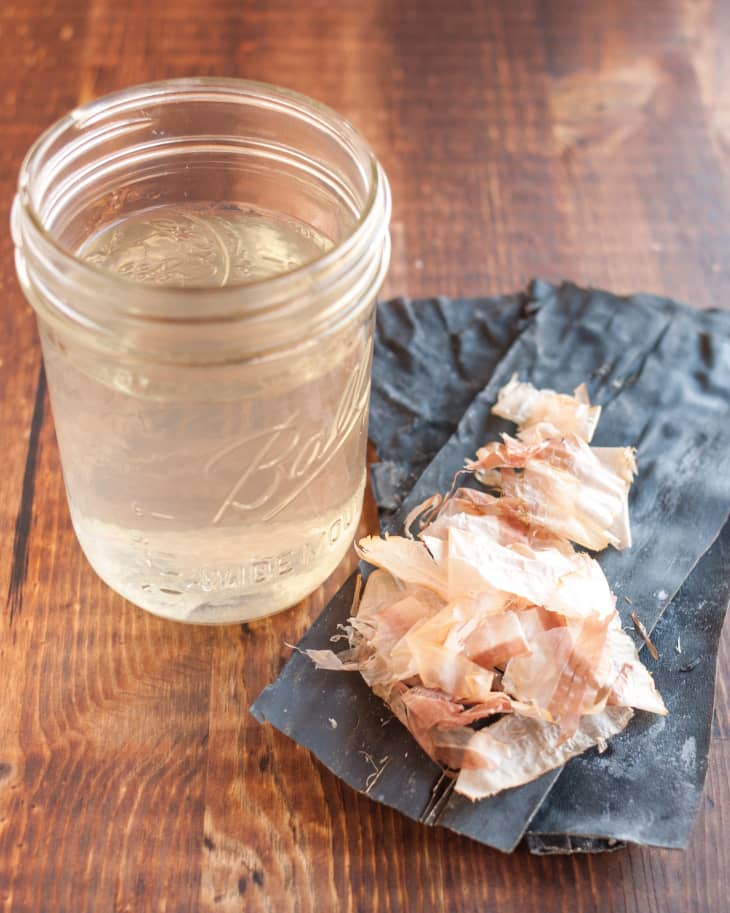How To Make Dashi

Dashi is an incredibly simple broth, and it forms one of the culinary cornerstones of Japanese cooking. It’s made in about 10 minutes with just three ingredients: water, kombu (dried kelp), and bonito fish flakes. The resulting clear broth tastes like the essence of the sea.
Dashi can be used to make a fantastic bowl of miso soup, to poach fish or vegetables, or to add savory umami flavor to any number of Japanese recipes. Here’s how to make dashi broth at home.
What Is Kombu?
Kombu is a type of kelp that has been dried and cut into sheets. Look closely and you’ll see powdery crystals clinging to the surface of the seaweed — these crystals of glutamic acid dissolve in the water and give the dashi much of it’s umami flavor.
You only need to use a small portion of kombu in each two-cup batch of dashi. You can break off a roughly two-inch piece with your hands or use kitchen shears to cut the kombu into smaller pieces.
Be careful not to boil the kombu or else it can give the dashi a bitter flavor and slick texture. Let the kombu and water warm together in the saucepan, and then remove the kombu just as the water starts to come to a boil.
What Are Bonito Flakes?
Called katsuobushi in Japanese, bonito flakes come from dried and thinly-shaved bonito fish. They add another layer of ocean-y complexity to this light broth. After simmering the bonito flakes in the broth for a minute or two, let them steep for a few minutes off the heat to deepen the flavors.
Where to Find Dashi Ingredients?
An Asian grocery store is your best bet for finding both kombu and bonito flakes. Whole Foods stores also reliably carry these ingredients. I’ve also seen more chain grocery stores starting to carry Asian ingredients, so it’s worth checking the “international” section at your local store before going on a quest for kombu and bonito flakes. If you’re still not having any luck, both ingredients can be purchased online.
If You’re Making Dashi, a Few Tips
- Remove the kombu as the water comes to a boil: Boiling the kombu can make the broth bitter and a bit slimy.
- For vegetarian dashi: If you’re vegetarian, you can skip the bonito flakes and use the dashi just after removing the kombu from the water. No additional boiling or steeping is necessary.
- For more deeply flavored dashi: Steep the kombu in the water overnight before continuing with the recipe.
What to Do with Dashi?
If you’ve never made dashi before, I recommend trying it first in a bowl of miso soup. The dashi adds a distinctive savory note to this simple soup. From there, you can branch out into other Japanese soups, like noodle soups or fish soups.
Dashi can also be used to poach vegetables or fish, as a dipping sauce for soba noodles or tempura, or to add savory depth to any Asian dishes.
How to Make Dashi
Makes about 2 cups
Nutritional Info
Ingredients
- 2 cups
water
2-inch piece kombu
- 1/2 cup
loosely packed dried bonito flakes (katsuobushi), optional
Instructions
Combine 2 cups water and 2-inch piece kombu in a 1-quart saucepan and set over medium heat.
Remove the kombu from the water just before it comes to a full boil.
Add 1/2 cup loosely packed dried bonito flakes, if using, and let the water come to a rapid simmer. Continue simmering for about 1 minute.
Remove the pan from heat and let the bonito steep in the broth for an additional 5 minutes.
Strain the bonito flakes from the both. Add additional water, pouring through the strained bonito, if needed to make 2 cups.
The broth can be used immediately, refrigerated for up to a week, or frozen for up to 3 months.
Recipe Notes
Storage: Refrigerate in an airtight container for up to 1 week or freeze for up to 3 months.
